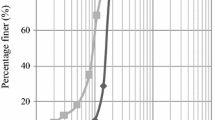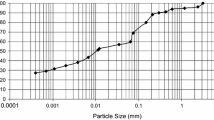Abstract
This paper presents the result of a laboratory study carried out on an expansive tropical black clay (also known as black cotton soil because the cotton plant thrives well on it) treated with locust bean waste ash (LBWA) using cement kiln dust (CKD) as an activator. Compaction was carried out using British Standard light energy. Results of index properties, compaction characteristics (maximum dry density, MDD and optimum moisture content, OMC) and strength characteristics (California bearing ratio, CBR and unconfined compressive strength, UCS) of black cotton soil treated with a maximum 8% CKD/10% LBWA blend by dry weight of soil is presented. Test results show that the strength properties of the treated soil generally increased with higher additive contents and peak values were recorded at 6% CKD/6% LBWA content. Based on strength criterion, an optimal 6% CKD/6% LBWA is recommended for treatment of black cotton soil for use as sub base material in road construction.











Similar content being viewed by others
References
AASHTO (1986) Standard specifications for transport materials and methods of sampling and testing, 14th edn. American Association of State Highway and Transport Officials (AASHTO), Washington, DC
Akinmade BO (2008) The effects of locust bean waste ash on the geotechnical properties of black cotton soil. Unpublished M.Sc. Thesis, Department of Civil Engineering, Ahmadu Bello University, Zaria
Amadi AA, Eberemu AO, Momoh HO (2013) Use of coir fiber reinforcement technique to improve strength of cement kiln dust treated black cotton soil subgrade. In: Proceedings of the international conference on geosynthetics for water resources and energy challenges (Geosynthetics 2013), 1–4 April, California, USA. Session 202: Natural Fiber Geosynthetics (2013), pp 223–229
ASTM (1992) Annual book of standards. American Society for Testing and Materials, Philadelphia. vol 04.08
Balogun LA (1991) Effect of sand and salt additives on some geotechnical properties of lime stabilized black cotton soil. Niger Eng 26:15–24
B.S. 1377 (1990) Methods of testing soil for civil engineering purposes. British Standards Institute, London
B.S. 1924 (1990) Methods of tests for stabilized soils. British Standards Institute, London
Chen FH (1988) Foundation on expansive soils. Elsevier, Amsterdam
Eberemu AO (2013) Evaluation of bagasse ash treated lateritic soil as a potential barrier material in waste containment application. Acta Geotech 8(4):407–421. https://doi.org/10.1007/s11440-012-0204-5
Gidigasu MD (1982) Importance of material selection, construction control and field performance studies in developing acceptance specification for laterite paving gravels. Sols Rocha 5:1
Hausmann MN (1990) Engineering principles of ground modification. McGraw-Hill, New York
Keerthi Y, Divya Kanthi P, Tejaswani N, Shyam Chamberlin K, Satyanarayana B (2013) Stabilization of clayey soil using cement kiln waste. Int J Adv Struct Geotech Eng 2 (2):77–82. ISSN:2319-5347
Kumar BRP, Sharma RS (2004) Effect of flyash on engineering properties of expansive soils. J Geotech Geoenviron ASCE 130(7):764–767
Lees G, Addelkader MO, Hamdani SK (1982) Sodium chloride as additive in lime- soil stabilization. J Inst Highw Eng 29:8–16
Mehta KS, Sonecha RJ, Daxini PD, Ratanpara PB, Gaikwad KS (2014). Analysis of engineering properties of black cotton soil &stabilization using by lime. Int J Eng Res Appl 4(5) (Version 3):25–32. ISSN: 2248-9622, www.ijera.com
Moses GK, Saminu A (2012) Cement kiln dust stabilization of compacted black cotton Soil. Electron J Geotech Eng 17:825–836
Nelson D, Miller J (1992) Expansive soils: problems and practices in foundation and pavement engineering. Wiley, New York
Nigerian General Specifications (1997) Roads and bridges. Federal Ministry of Works, Abuja, Nigeria
Ola SA (1978) The geology and geotechnical properties of the black cotton soils of North Eastern Nigeria. Eng Geol 12:375–391
Ola SA (1983) The geotechnical properties of black cotton soils of North Eastern Nigeria. In: Ola SA (ed) Tropical soils of Nigeria in engineering practice. Balkema, Rotterdam, pp 160–178
Ola SA (1991) Laboratory testing and geotechnical characterization of black cotton soil and expansive shales in Nigeria. In: Proceedings 9th regional conference for Africa on soil mechanics and foundation engineering, Balkema, Rotterdam, pp 991–995
Osinubi KJ (1995) Lime modification of black cotton soils. Spectr J 2:112–122
Osinubi KJ (1999) Evaluation of admixture stabilization of Nigerian black cotton soil. Niger Soc Eng Techn Trans 34:88–96
Osinubi KJ, Oyelakin MA (2012) Optimizing soil-cement-ash stabilization mix for maximum compressive strength: a case study of the tropical clay sub-base material stabilized with cement-locust bean waste ash. In: Laryea S, Agyepong SA, Leiringer R, Hughes W (eds) Proceedings 4th West Africa Built Environment Research (WABER) Conference, 24–26 July 2012. Abuja, Nigeria, p 1207-121
Osinubi KJ, Stephen TA (2005) Economic utilization of an agro-industrial waste—bagasse ash. In: Proceedings of the 4th Nigerian materials congress (NIMACON 2005), Zaria, Nigeria, pp 36–40
Osinubi KJ, Akinmade OB, Eberemu AO (2009a) Stabilization potentials of locust bean waste ash on black cotton soil. J Eng Res 14:1–13
Osinubi KJ, Bafyau V, Eberemu AO. (2009b) Bagasse ash stabilization of lateritic soil. Contribution to chapter 5 in appropriate technologies for environmental protection in the developing world edited by EK Yanful. Springer, Netherlands, pp 281–290
Osinubi KJ, Eberemu AO, Oyelakin MA (2011) Improvement of black cotton soil with ordinary portland cement: locust bean waste ash blend. EJGE Bund F 16:619–627
Osinubi KJ, Eberemu AO, Akinmade OB (2016) Evaluation of strength characteristics of tropical black clay treated with locust bean waste ash. Geotech Geol Eng J 34(2):635–646. https://doi.org/10.1007/s10706-015-9972-7
Oyetola EB, Abdullahi M (2006) The use of rice husk ash in low—cost sandcrete block production. Leonardo Electron J Pract Technol 8:58–70
Peter GM (1993) Fly ash stabilization of tropical Hawai soils. In: Sharp KD (ed) Fly ash for soil improvement. Geotechnical Engineering Division of ASCE, Geotechnical Special Publications, 36:15–20
Salahudeen AB, Eberemu AO, Osinubi KJ (2014) Assessment of cement kiln dust-treated expansive soil for the construction of flexible pavements. Geotech Geol Eng J 32(4):923–931. https://doi.org/10.1007/s10706-014-9769-0, ISSN: 0960-3182
Sani JE, Yohanna P, Chukwujama IA (2018) Effect of rice husk ash admixed with treated sisal fibre on properties of lateritic soil as a road construction material. J King Saud Univ: Eng Sci 1:1. https://doi.org/10.1016/j.jksues.2018.11.001
Stephen AT (2006) Stabilization potential of bagasse ash on black cotton soil. Unpublished M.Sc. Thesis, Department of Civil Engineering, Ahmadu Bello University, Zaria
Thirumalai R, Suresh Babu S, Naveennayak V, Nirmal R, Lokesh G (2017) A review on stabilization of expansive soil using industrial solid wastes. Engineering 9:1008–1017. https://doi.org/10.4236/eng.2017.912060
TRRL (1977) A guide to the structural design of bitumen surfaced roads in tropical and sub-tropical countries. Transport and Road Research Laboratory, Road Note 31, H. M. S. O., London
Warren KW, Kirby TM (2004) Expansive clay soil: a widespread and costly geohazard. Geostrata. Geo-Inst Am Soc Civ Eng 1:24–28
Author information
Authors and Affiliations
Corresponding author
Additional information
Publisher's Note
Springer Nature remains neutral with regard to jurisdictional claims in published maps and institutional affiliations.
Rights and permissions
About this article
Cite this article
Eberemu, A.O., Osinubi, K.J., Ijimdiya, T.S. et al. Cement Kiln Dust: Locust Bean Waste Ash Blend Stabilization of Tropical Black Clay for Road Construction. Geotech Geol Eng 37, 3459–3468 (2019). https://doi.org/10.1007/s10706-018-00794-w
Received:
Accepted:
Published:
Issue Date:
DOI: https://doi.org/10.1007/s10706-018-00794-w




